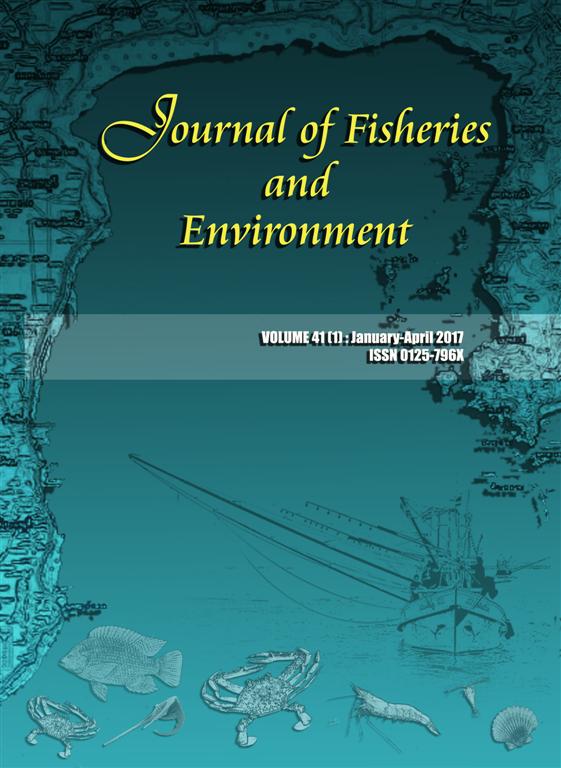Influence of Diet on the Ingestion Rate of the Harpacticoid Copepod Euterpina acutifrons (Dana, 1847)
Main Article Content
Abstract
The influence of the type of diet, concentration, and sex on the ingestion rate of the harpacticoid copepod Euterpina acutifrons was examined in controlled laboratory experiments. Four dietary treatments were investigated in 1:1proportion: Isochrysis galbana, L galbana and Tetraselmis suecica, I.galbana and Dunaliella sp., and L galbana and baker's yeast (Saccharomyces cerevisiae). Furthermore, six different cell concentrations were tested for each combination: 500, 700, 1,000, 1,500, 10,000 and 20,000 cell mr 1. All experiments were carried out under the photoperiod of 12h:12h (light:dark cycle), with salinity at 32±1 psu and at 28±2 °C for 24 hours. The results showed no difference in the ingestion rates among different diets or between male and female E. acutifrons (P>0.05). This indicates that mature E. acutifrons can feed on a variety of foods. However, different cell concentrations significantly influenced the ingestion rate of E. acutifrons (P<0.05). The highest ingestion rate (15,563 cells E. acutifrons- 1 day-1) for E. acutifrons was observed when a combination of I.galbana and Dunaliella sp. at 20,000 cells m1-1was provided. Further studies are needed to obtain the maximum ingestion rate for E. acutifrons.
Article Details
References
2. Ajiboye, O. O., A. F.Yakubu, T. E. Adams, E. D. Olaji and N. A. Nwogu. 2011. A review of the use of copepods in marine fish larvicuture. Reviews in Fish Biology and Fisheries 21: 225-246.
3. Camus,-T. and C. Zeng. 2012. Reproductive performance, survival and development of nauplii and copepodites, sex ratio and adult life expectancy of the harpacticoid copepod, Euterpina acutifrons, fed different microalgal diets. Aquaculture Research 43:1159-1169.
4. Delbare,D., P. Dhert and P. Lavens. 1996. Zooplankton: Manual on the production and use of live food for aquaculture. FAQ Fisheries Technical Papers 361: 252-282.
5. Dhanker, R. and J. Hwang. 2013. Predation by Apocyclops royi (Cyclopoid: copepod) on ciliates and rotifers. Journal of Marine Science and Technology (Taiwan) 21: 246-251.
6. Diaz., E., U. Cotano and F. Vtllate. 2003. Reproductive response of Euterpina acutifrons in two estuaries of the Basque Country (Bay of Biscay) with contrasting nutritional environment. Journal of Experimental Marine Biology and Ecology 292: 213-230.
7. Guisande, C., I. Maneiro and I. Riveiro. 1999. Homeostasis in the essential amino acid composition of the marine copepod Euterpina acutifrons. Limnology and Oceanography 44(3): 691-696.
8. Guisande, C., J. Sanchez, I. Maneiro and A. Miranda. 1996. Trade-off between off spring number and off spring size in the marine copepod Euterpina acutifrons at different food concentrations. Marine Ecology Progress Series 143(1): 37-44.
9. Jakobsen, H. H. and P. J. Hansen. 1997. Prey size selection, growth and grazing responses of a small heterotrophic dinoflagellate Gymnodinium sp. and a ciliate Balanion comatum: a comparative study. Marine Ecology Progress Series 158:75-86.
10. Jitchum, P. and L. Wongrat. 2009. Community structure and abundance of epipelagic copepods in a shallow protected bay, Gulf of Thailand. Kasetsart University Fisheries Research Bulletin 33(1): 28-40.
11. Johnson, M. W.and J. B. Olson. 1948. The life history and biology of a marine harpacticoid copepod, Tisbe furcata (Baird). The Biological Bulletin 95(3): 320-332.
12. Kraul, S. 2006. Live food for marine fish larvae, pp. 55-60. In Suarez E C, Marie DR, Salazar M T,Nieto L6pez M G, Villareal Cavazos D A, Puello Cruzy Armando Garcia Ortega AC (Eds.). Advances en Nutricion Acuicola VIII.VIII Symposium International de Nutrición Acuicola. 15-17 Noviembre. Univesidad Autónoma de Nuevo León, Mexico
13. Kraul, S., H. Ako, A. Nelson, K. Brittain and A. Ogasawara. 1992. Evaluation of live feeds for larval and postlarval rnahimahi, Coryphaena hippurus. Journal of the World Aquaculture Society 23: 299-306.
14. Matias-Peralta, H. M., F. M. Yusoff: M. Shariff and S. Mohamaed. 2012. Reproductive performance, growth and development time of a tropical harpacticoid copepod, Nitocra affins califarnica Lang, 1965 fed with different microalgal diets. Aquaculture 344-349 (1):168-173.
15. Maiphae, S. and P. Sa-Ardrit 2011. Marine copepods at Mo Ko Thale Tai, Gulf of Thailand. Songklanakarin Journal of Science and Technology 33: 641-651.
16. Nanton, D. A. and J. D. Castell. 1999. The effect of temperature and dietary fatty acids on the fatty acid composition of harpacticoid copepods for use as live food for marine fish larvae. Aquaculture 175: 167-181.
17. Oliveira Lemos, V., R Marinho ca Costa and L. C. C. Pereira. 2006. Filtration and ingestion rates of Thalassiosira weissflogii (Bacillariophyta) by Euterpina acutifrons Dana (Copepoda). Boletim Museu Paraense Emilio Goeldi Cincias Naturais 1(3):121-127.
18. Promkaew, S., A. Piurnsomboon and N. Paphavasit. 2012. Diversity of copepods in Pak Phanang Bay, Nakhon Si Tharnmarat Province. KKU Science Journal 40(1): 281-292. (inThai)
19. Sautour, B. and J. Castel. 1993. Feeding behaviour of the coastal copepod Euterpina acutifrons on small particles. Cahiers de Biologie Marine 34: 239-251.
20. Tanyaros, S., C. Sujarit, N. Jansri and W. Tarangkoon. 2016. Baker's yeast as a substitute for microalgae in the hatchery rearing of larval and juvenile tropical oyster (Crassostrea belcheri, Sowerby 1871). Journal of Applied Aquaculture 28(1): 35-46
21. Walne, P. R. 1974. Culture of bivalve molluscs, 5O years experience at Conway. Fishing News (Books) Ltd., London.173 pp.
22. Zaleha, K., B. Ibrahim, B. Akbar John and B. Y. Karnaruzzarnan. 2012. Generation time of some marine harpacticoid species in laboratory condition. Journal of Biological Sciences 12:433-437.


